light Oldsmobile Aurora 1997 s User Guide
[x] Cancel search | Manufacturer: OLDSMOBILE, Model Year: 1997, Model line: Aurora, Model: Oldsmobile Aurora 1997Pages: 404, PDF Size: 20.75 MB
Page 74 of 404
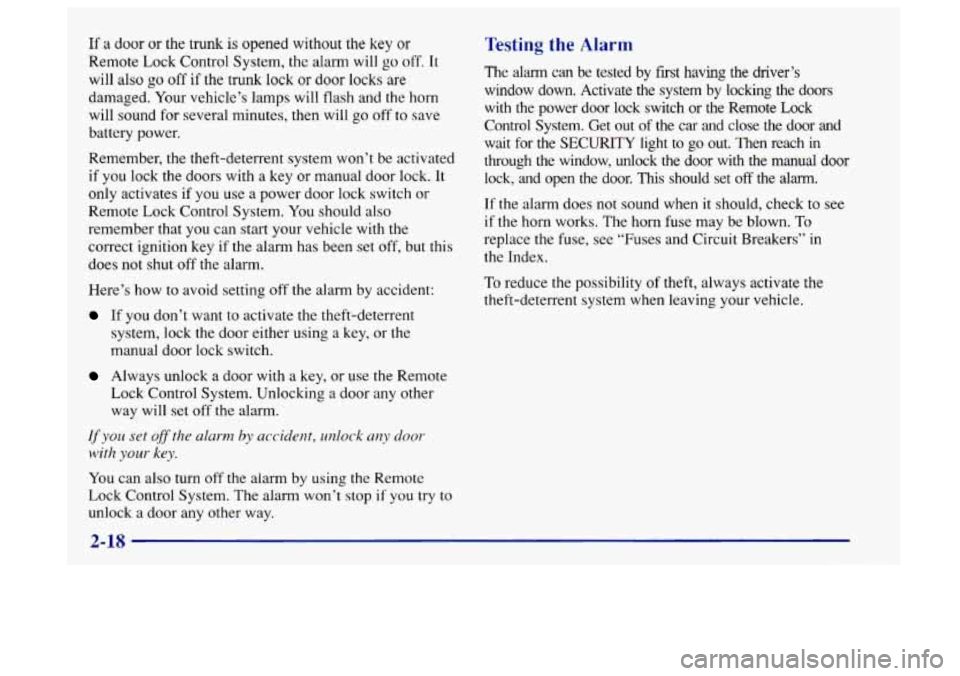
If a door or the trunk is opened without the key or
Remote Lock Control System, the alarm
will go off. It
will also go
off if the trunk lock or door locks are
damaged. Your vehicle’s lamps will flash and the horn
will sound for several minutes, then will go off to save
battery power.
Remember,
the theft-deterrent system won’t be activated
if
you lock the doors with a key or manual door lock. It
only activates
if you use a power door lock switch or
Remote Lock Control System. You should also
remember that you can start your vehicle with the
correct ignition key if the alarm has been set off, but this
does not shut off the alarm.
Here’s how to avoid setting off the alarm by accident:
If you don’t want to activate the theft-deterrent
system, lock the door either using a key, or
the
manual door lock switch.
Always unlock a door with a key, or use the Remote
Lock Control System. Unlocking a door any other
way will set off the alarm.
If you set off the alarm by accident, unlock any door
with your key.
You can also turn off the alarm by using the Remote
Lock Control System. The alarm won’t stop if
you try to
unlock
a door any other way.
Testing the Alarm
The alarm can be tested by fist having the driver’s
window down. Activate
the system by locking the doors
with the power door lock switch or the Remote Lock
Control System. Get out of the car and close the door and
wait for the
SECURITY light to go out. Then reach in
through the window, unlock the door with the manual door
lock, and open the door. This should set
off the alarm.
If the alarm does not sound when it should, check
to see
if the horn works. The
horn fuse may be blown. To
replace the fuse, see “Fuses and Circuit Breakers” in
the Index.
To reduce the possibility of theft, always activate the
theft-deterrent system when leaving your vehicle.
2-18
Page 75 of 404
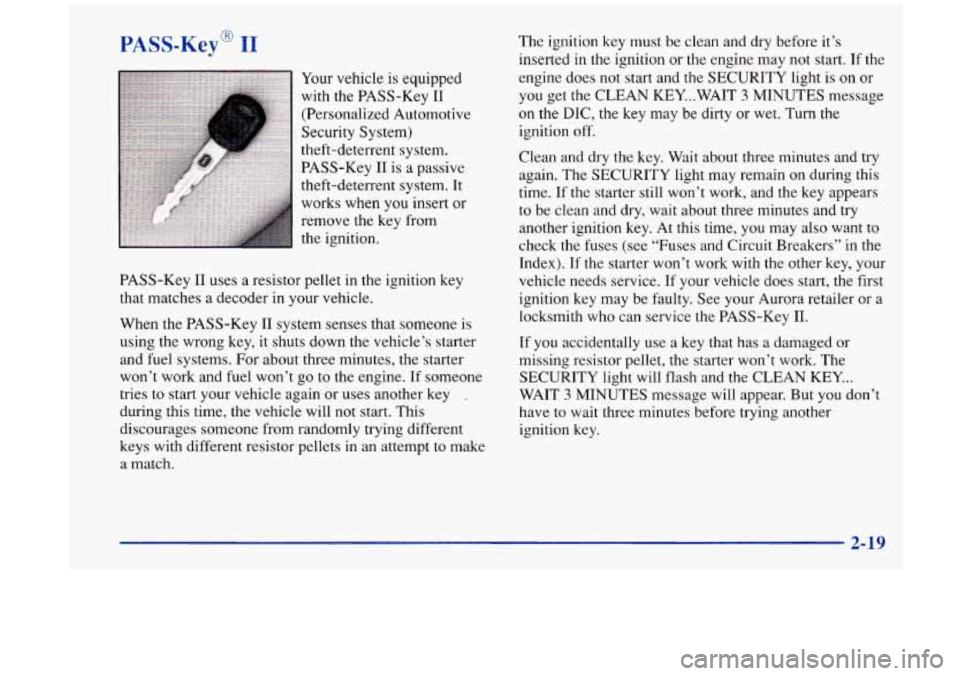
PASS-K~~~ 11
Your vehicle is equipped
with the PASS-Key I1
(Personalized Automotive
Security System)
theft-deterrent system.
PASS-Key
I1 is a passive
theft-deterrent system. It
works when you insert or
remove the key from
the ignition.
PASS-Key I1 uses a resistor pellet in the ignition key
that matches a decoder in your vehicle.
When the PASS-Key
I1 system senses that someone is
using the wrong key, it shuts down the vehicle’s starter
and fuel systems. For about three minutes, the starter
won’t work and fuel won’t go to the engine. If someone
tries to start your vehicle again or uses another key
,
during this time, the vehicle will not start. This
discourages someone from randomly trying different
keys with different resistor pellets in an attempt to make
a match. The
ignition key must be clean and dry before it’s
inserted in the ignition or the engine may not start.
If the
engine does not start and the SECURITY light is on
or
you get the CLEAN KEY. ..WAIT 3 MINUTES message
on the DIC, the key may be dirty or wet. Turn the
ignition
off.
Clean and dry the key. Wait about three minutes and try
again. The SECURITY light may remain on during this
time. If the starter still won’t work, and the key appears
to be clean and dry, wait about three minutes and try
another ignition key. At this time,
you may also want to
check the fuses
(see “Fuses and Circuit Breakers” in the
Index). If the starter won’t work with the other key, your
vehicle needs service. If your vehicle does start, the first
ignition key may be faulty. See your Aurora retailer or a
locksmith who can service the PASS-Key
11.
If you accidentally use a key that has a damaged or
missing resistor pellet, the starter won’t work. The
SECURITY light will flash and the CLEAN
KEY. ..
WAIT 3 MINUTES message will appear. But you don’t
have to wait three minutes before trying another
ignition key.
Page 76 of 404
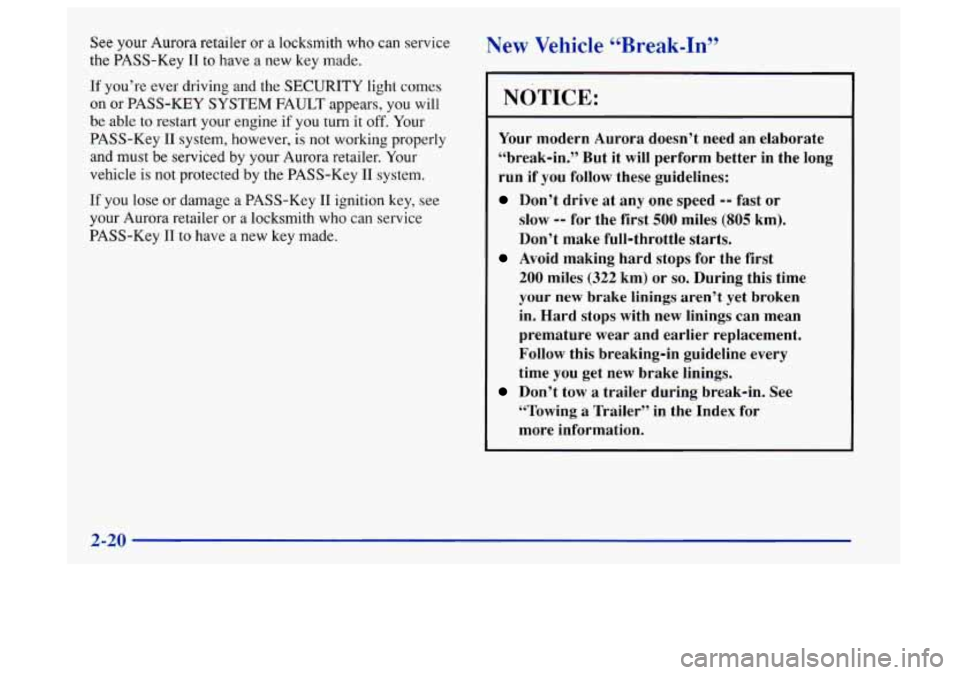
See your Aurora retailer or a locksmith who can service
the PASS-Key
I1 to have a new key made.
If you’re ever driving and the SECURITY light comes
on or PASS-KEY SYSTEM FAULT appears, you will
be able to restart your engine if you
turn it off. Your
PASS-Key
I1 system, however, is not working properly
and must
be serviced by your Aurora retailer. Your
vehicle is not protected by the PASS-Key I1 system.
If
you lose or damage a PASS-Key I1 ignition key, see
your Aurora retailer or
a locksmith who can service
PASS-Key
I1 to have a new key made.
New Vehicle CCBreak-InSS
NOTICE:
Your modern Aurora doesn’t need an elaborate
“break-in.” But it will perform better in the long
run if you follow these guidelines:
Don’t drive at any one speed -- fast or
slow -- for the first 500 miles (805 km).
Don’t make full-throttle starts.
200 miles (322 km) or so. During this time
your new brake linings aren’t yet broken
in. Hard stops with new linings can mean
premature wear and earlier replacement.
Follow this breaking-in guideline every
time you get new brake linings.
Don’t tow a trailer during break-in. See
“Towing
a Trailer” in the Index for
more information.
Avoid making hard stops for the first
2-20
Page 77 of 404
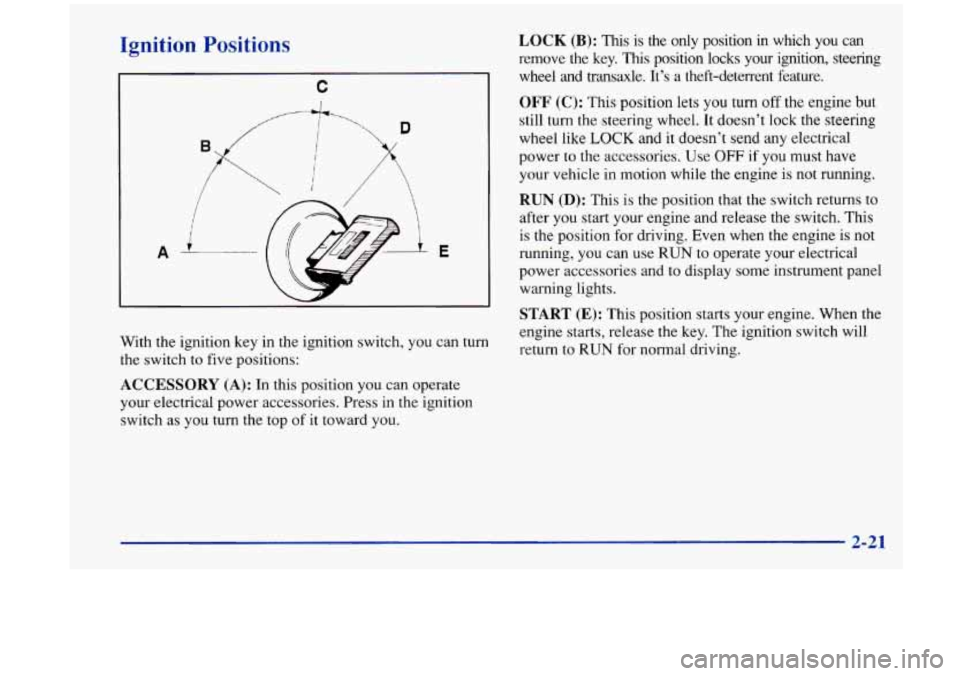
Ignition Positions
C
D
1 I
A E
With the ignition key in the ignition switch, you can turn
the switch to five positions:
LOCK (B): This is the only position in which you can
remove the key. This position locks your ignition, steering
wheel and transaxle. It’s a theft-deterrent feature.
OFF (C): This position lets you turn off the engine but
still turn the steering wheel. It doesn’t lock the steering
wheel like
LOCK and it doesn’t send any electrical
power to the accessories. Use
OFF if you must have
your vehicle in motion while the engine is not running.
RUN (D): This is the position that the switch returns to
after you start your engine and release the switch. This
is the position for driving. Even when the engine
is not
running, you can use
RUN to operate your electrical
power accessories and to display some instrument panel
warning lights.
START (E): This position starts your engine. When the
engine starts, release the key. The ignition switch will
return to
RUN for normal driving.
ACCESSORY (A): In this position you can operate
your electrical power accessories. Press in the ignition
switch as you turn the top of it toward you.
2-21
Page 84 of 404
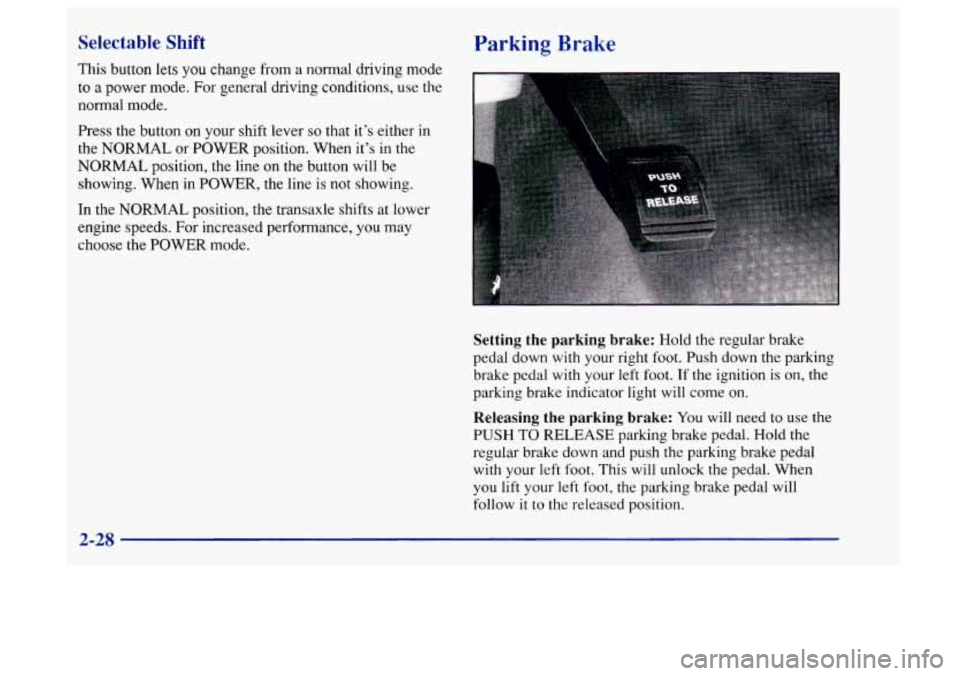
Selectable Shift
This button lets you change from a normal driving mode
to a power mode.
For general driving conditions, use the
normal mode.
Press the button
on your shift lever so that it’s either in
the
NORMAL or POWER position. When it’s in the
NORMAL position, the line on the button will be
showing. When in POWER, the line is not showing.
In the NORMAL position, the transaxle shifts at lower
engine speeds. For increased performance,
you may
choose the POWER mode.
Parking Brake
Setting the parking brake: Hold the regular brake
pedal down with your right foot. Push down the parking
brake pedal with your left
foot. If the ignition is on, the
parking brake indicator light will come
on.
Releasing the parking brake: You will need to use the
PUSH
TO RELEASE parking brake pedal. Hold the
regular brake down and push the parking brake pedal with your left foot. This will unlock the pedal. When
you lift your left foot, the parking brake pedal will
follow
it to the released position.
2-28
Page 85 of 404
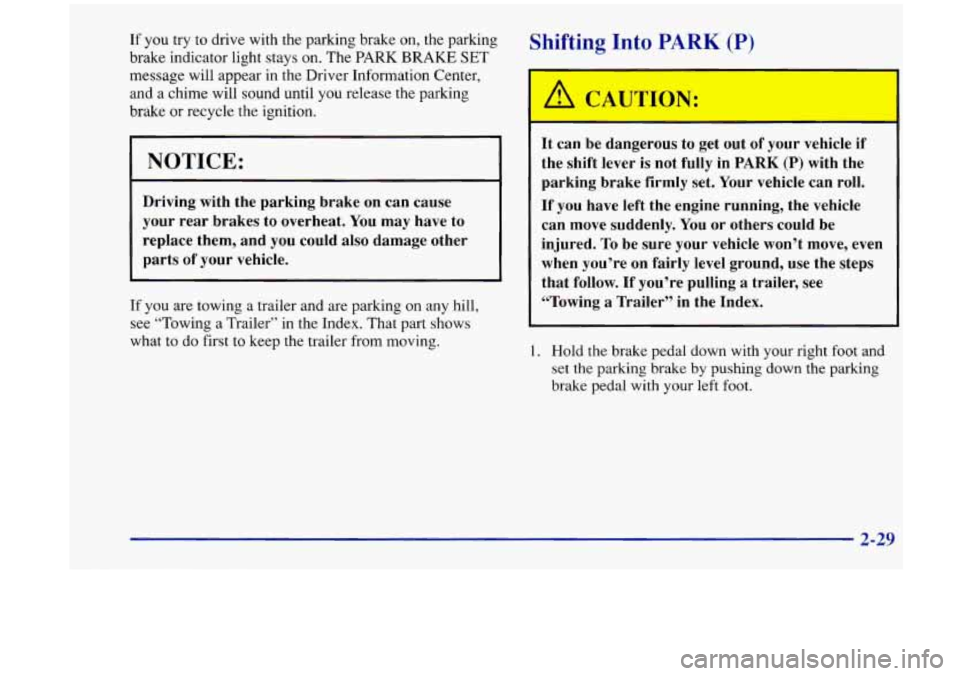
If you try to drive with the parking brake on, the parkin
brake indicator light stays
on. The PARK BRAKE SET
message will appear in the Driver Information Center,
and a chime will sound until you release the parking
brake or recycle the ignition.
NOTICE:
Driving with the parking brake on can cause
your rear brakes to overheat.
You may have to
replace them, and you could also damage other
parts of your vehicle.
If you are towing a trailer and are parking on any hill,
see “Towing a Trailer” in the Index. That part shows
what to do first to keep the trailer from moving.
Shifting Into PARK (P)
It can be dangerous to get out of your vehicle if
the shift lever
is not fully in PARK (P) with the
parking brake firmly set. Your vehicle can roll.
If you have left the engine running, the vehicle
can move suddenly.
You or others could be
injured. To be sure your vehicle won’t move, even
when you’re on
fairly level ground, use the steps
that follow.
If you’re pulling a trailer, see
“Towing
a Trailer’’ in the Index.
1. Hold the brake pedal down with your right foot and
set the parking brake by pushing down the parking
brake pedal with your left
foot.
2-29
Page 93 of 404
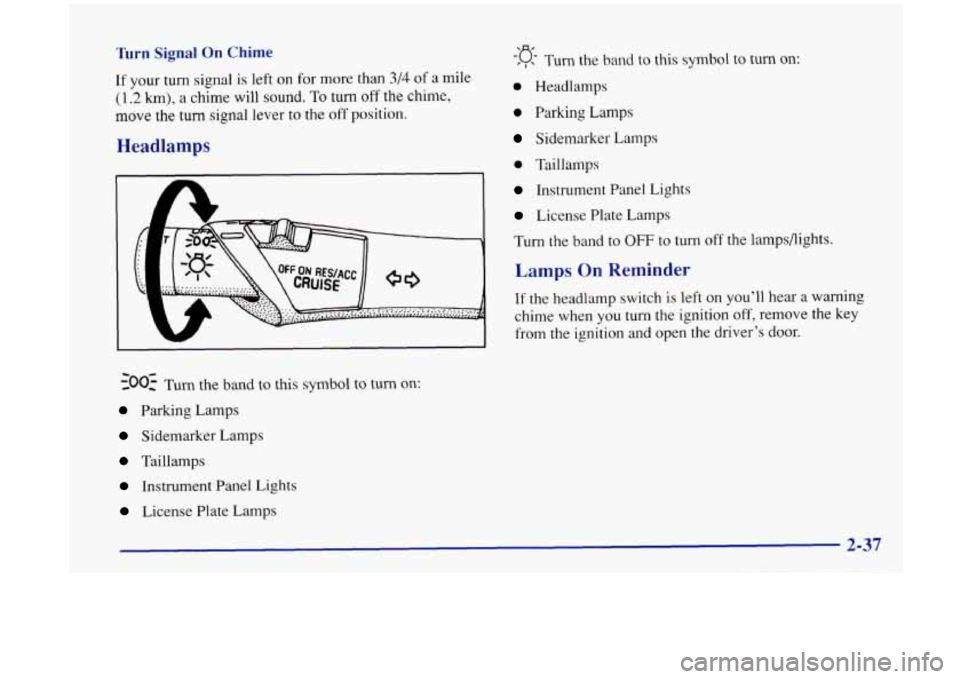
Turn Signal On Chime
If your turn signal is left on for more than 3/4 of a mile
(1.2 km), a chime will sound. To turn off the chime,
move the turn signal lever to the off position.
Headlamps
Turn the band to this symbol to turn on:
Parking Lamps
Sidemarker Lamps
Taillamps
Instrument Panel Lights
License Plate Lamps
-‘Q , , Turn the band to this symbol to turn on:
0 Headlamps
0 Parking Lamps
Sidemarker Lamps
0 Taillamps
Instrument Panel Lights
License Plate Lamps
Turn the band to
OFF to turn off the lampsflights.
Lamps On Reminder
If the headlamp switch is left on you’ll hear a warning
chime when you turn the ignition
off, remove the key
from the ignition and open the driver’s door.
Page 94 of 404
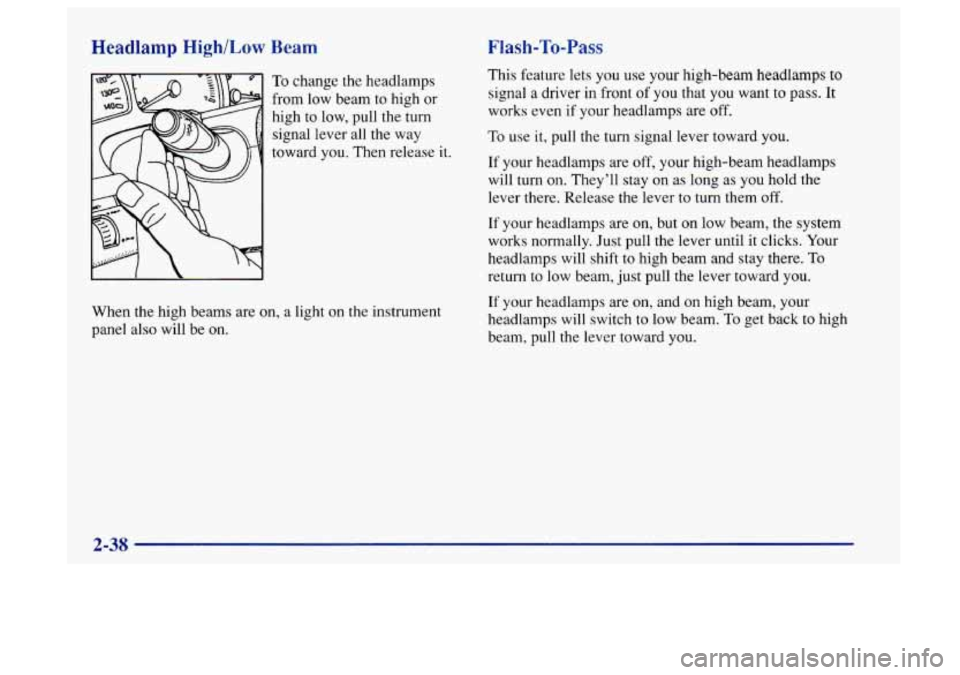
Headlamp High/Low Beam
To change the headlamps
from low beam to high or
high to low, pull the turn
signal lever all the way
toward you. Then release
it.
When the high beams are on, a light on the instrument
panel also will be on.
Flash-To-Pass
This feature lets you use your high-beam headlamps to
signal a driver in front of you that you want to pass. It
works even if your headlamps are off.
To use it, pull the turn signal lever toward you.
If your headlamps are
off, your high-beam headlamps
will turn
on. They’ll stay on as long as you hold the
lever there. Release the lever to turn them
off.
If your headlamps are on, but on low beam, the system
works normally.
Just pull the lever until it clicks. Your
headlamps will shift to high beam and stay there. To
return to low beam, just pull the lever toward you.
If your headlamps are on, and on high beam, your
headlamps will switch to low beam.
To get back to high
beam,
pull the lever toward you.
2-38
Page 95 of 404
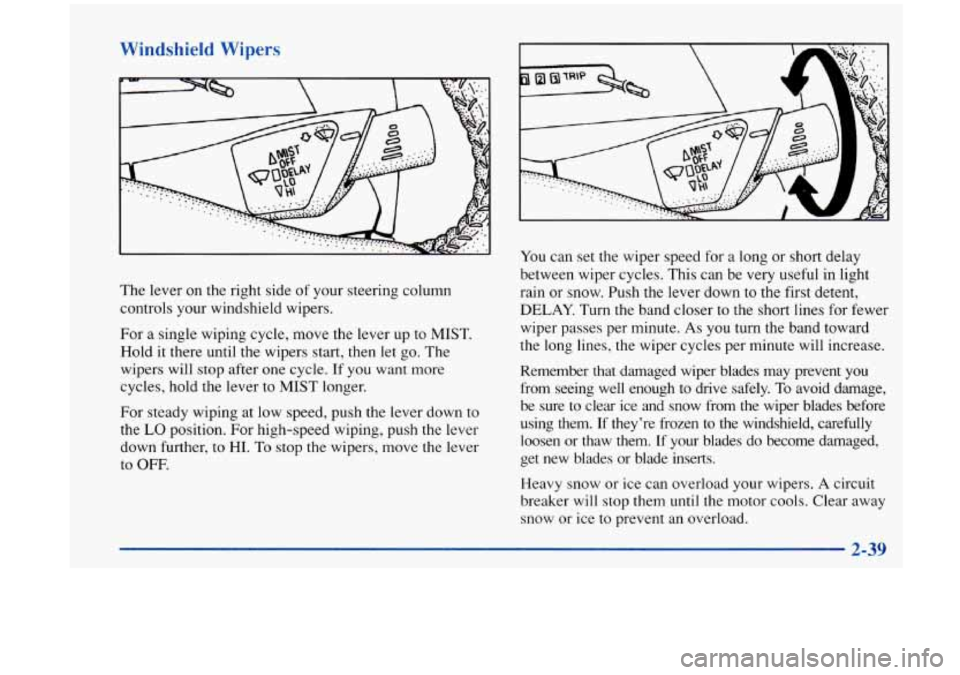
Windshield Wipers
The lever on the right side of your steering column
controls your windshield wipers.
For a single wiping cycle, move the lever up to MIST.
Hold
it there until the wipers start, then let go. The
wipers will stop after one cycle.
If you want more
cycles, hold the lever to
MIST longer.
For steady wiping at low speed, push the lever down to
the
LO position. For high-speed wiping, push the lever
down further, to HI. To stop the wipers, move the lever
to
OFF.
You can set the wiper speed for a long or short delay
between wiper cycles. This can be very useful in light
rain or snow. Push the lever down
to the first detent,
DELAY. Turn the band closer to the short lines for fewer
wiper passes per minute.
As you turn the band toward
the long lines, the wiper cycles per minute will increase.
Remember that damaged wiper blades may prevent you
from seeing well enough to drive safely. To avoid damage,
be sure to clear ice and snow from the wiper blades before
using them.
If they’re frozen to the windshield, carefully
loosen or thaw them.
If your blades do become damaged,
get new blades or blade inserts.
Heavy snow or ice can overload your wipers.
A circuit
breaker will stop them until the motor cools. Clear away
snow or ice to prevent an overload.
2-39
Page 98 of 404
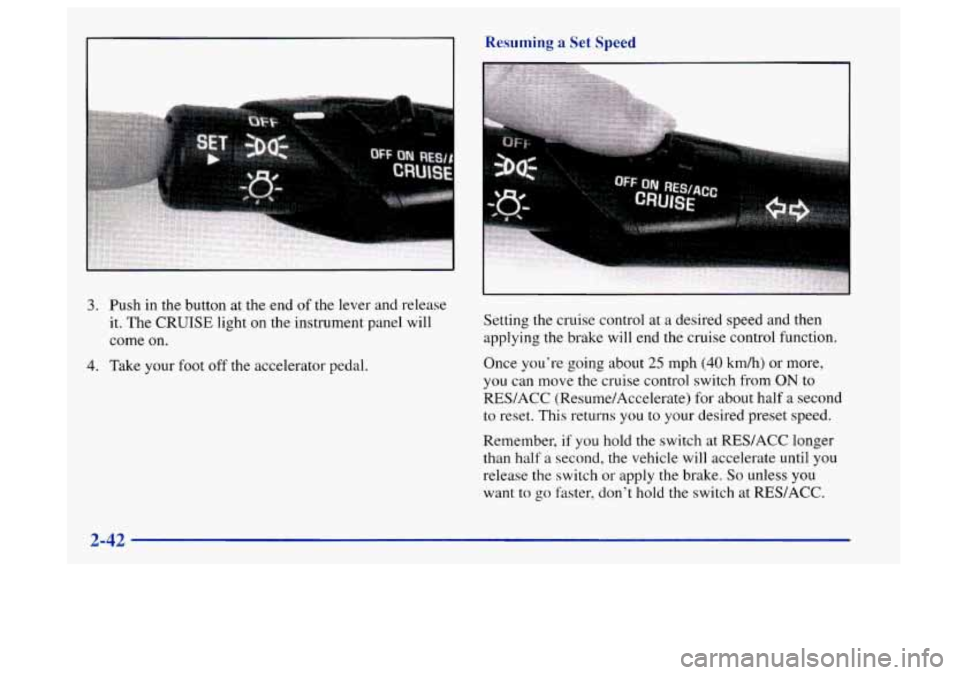
.. I
3. Push in the button at the end of the lever and release
it. The CRUISE light on the instrument panel will
come
on.
4. Take your foot off the accelerator pedal.
Resuming a Set Speed
Setting the cruise control at a desired speed and then
applying the brake will end the cruise control function.
Once you’re going about
25 mph (40 km/h) or more,
you can move the cruise control switch from ON to
REWACC (Resume/Accelerate) for about half
a second
to reset. This returns
you to your desired preset speed.
Remember, if
you hold the switch at RES/ACC longer
than half a second, the vehicle will accelerate until you
release the switch
or apply the brake. So unless you
want to
go faster, don’t hold the switch at REWACC.
2-42